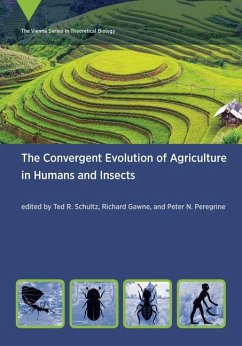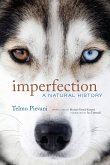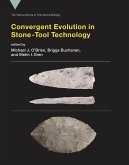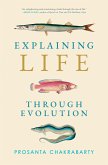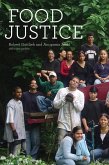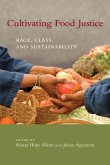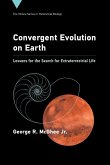- Broschiertes Buch
- Merkliste
- Auf die Merkliste
- Bewerten Bewerten
- Teilen
- Produkt teilen
- Produkterinnerung
- Produkterinnerung
"An edited collection about the evolution of agriculture in humans and insects"--
Andere Kunden interessierten sich auch für
![Salt Wars Salt Wars]() Michael F. JacobsonSalt Wars23,99 €
Michael F. JacobsonSalt Wars23,99 €![Imperfection Imperfection]() Telmo PievaniImperfection28,99 €
Telmo PievaniImperfection28,99 €![Convergent Evolution in Stone-Tool Technology Convergent Evolution in Stone-Tool Technology]() Convergent Evolution in Stone-Tool Technology60,99 €
Convergent Evolution in Stone-Tool Technology60,99 €![Explaining Life through Evolution Explaining Life through Evolution]() Prosanta ChakrabartyExplaining Life through Evolution16,99 €
Prosanta ChakrabartyExplaining Life through Evolution16,99 €![Food Justice Food Justice]() Robert Gottlieb (Henry R. Luce Professor of Urban and EnvironmentalFood Justice30,99 €
Robert Gottlieb (Henry R. Luce Professor of Urban and EnvironmentalFood Justice30,99 €![Cultivating Food Justice Cultivating Food Justice]() Cultivating Food Justice43,99 €
Cultivating Food Justice43,99 €![Convergent Evolution on Earth Convergent Evolution on Earth]() George R McGhee Jr. (Rutgers University)Convergent Evolution on Earth54,99 €
George R McGhee Jr. (Rutgers University)Convergent Evolution on Earth54,99 €-
-
-
"An edited collection about the evolution of agriculture in humans and insects"--
Hinweis: Dieser Artikel kann nur an eine deutsche Lieferadresse ausgeliefert werden.
Hinweis: Dieser Artikel kann nur an eine deutsche Lieferadresse ausgeliefert werden.
Produktdetails
- Produktdetails
- Verlag: MIT Press Ltd
- Seitenzahl: 352
- Erscheinungstermin: 22. Februar 2022
- Englisch
- Abmessung: 178mm x 254mm x 25mm
- Gewicht: 706g
- ISBN-13: 9780262543200
- ISBN-10: 0262543206
- Artikelnr.: 62649423
- Herstellerkennzeichnung
- Libri GmbH
- Europaallee 1
- 36244 Bad Hersfeld
- gpsr@libri.de
- Verlag: MIT Press Ltd
- Seitenzahl: 352
- Erscheinungstermin: 22. Februar 2022
- Englisch
- Abmessung: 178mm x 254mm x 25mm
- Gewicht: 706g
- ISBN-13: 9780262543200
- ISBN-10: 0262543206
- Artikelnr.: 62649423
- Herstellerkennzeichnung
- Libri GmbH
- Europaallee 1
- 36244 Bad Hersfeld
- gpsr@libri.de
edited by Ted R. Schultz, Richard Gawne, and Peter N. Peregrine
Series Foreword ix
Introduction 1
I Comparative Analyses of Human and Nonhuman Agriculture
1 Convergent Evolution of Agriculture in Bilaterian Animals: An Adaptive
Landscape Perspective 7
2 The Convergent Evolution of Agriculture: A Systematic Comparative
Analysis 31
II Conflict and Cooperation in Human and Nonhuman Agriculture
3 If Group Selection is Weak, What Can Agriculture Learn from
Fungus-Farming Insects? 49
4 The Sociobiology of Domestication 61
5 Lifetime Commitment between Social Insect Families and Their Fungal
Cultivars Complicates Comparisons with Human Farming 73
III The Diversity of Insect Agriculture
6 Fungus-Growing Termites: An Eco-Evolutionary Perspective 89
7 Mycangia Define the Diverse Ambrosia Beetle-Fungus Symbioses 105
8 Agricultural and Proto-Argicultural Symbioses in Ants 143
9 Plant Farming by Ants: Convergence and Divergence in the Evolution of
Agriculture 161
IV Patterns of Convergence in Agriculturalists, Domesticates, and Parasites
10 Coevolution in the Arable Battlefield: Pathways to Crop Domestication,
Cultural Practices, and Parasitic Domesticoids 177
11 Convergent Adaptation and Specialization of Eukaryotic Pathogens across
Agricultural Systems 209
12 Evaluating Potential Proximate and Ultimate Causes of Phenotypic Change
in the Human Skeleton over the Agricultural Transition 225
13 Hammond's Law: A Mechanism Governing the Development and Evolution of
Form in Domesticated Organisms 257
14 The Convergent Evolution of Agriculture in Humans and Fungus-Farming
Ants 281
Contributors 315
Index 317
Introduction 1
I Comparative Analyses of Human and Nonhuman Agriculture
1 Convergent Evolution of Agriculture in Bilaterian Animals: An Adaptive
Landscape Perspective 7
2 The Convergent Evolution of Agriculture: A Systematic Comparative
Analysis 31
II Conflict and Cooperation in Human and Nonhuman Agriculture
3 If Group Selection is Weak, What Can Agriculture Learn from
Fungus-Farming Insects? 49
4 The Sociobiology of Domestication 61
5 Lifetime Commitment between Social Insect Families and Their Fungal
Cultivars Complicates Comparisons with Human Farming 73
III The Diversity of Insect Agriculture
6 Fungus-Growing Termites: An Eco-Evolutionary Perspective 89
7 Mycangia Define the Diverse Ambrosia Beetle-Fungus Symbioses 105
8 Agricultural and Proto-Argicultural Symbioses in Ants 143
9 Plant Farming by Ants: Convergence and Divergence in the Evolution of
Agriculture 161
IV Patterns of Convergence in Agriculturalists, Domesticates, and Parasites
10 Coevolution in the Arable Battlefield: Pathways to Crop Domestication,
Cultural Practices, and Parasitic Domesticoids 177
11 Convergent Adaptation and Specialization of Eukaryotic Pathogens across
Agricultural Systems 209
12 Evaluating Potential Proximate and Ultimate Causes of Phenotypic Change
in the Human Skeleton over the Agricultural Transition 225
13 Hammond's Law: A Mechanism Governing the Development and Evolution of
Form in Domesticated Organisms 257
14 The Convergent Evolution of Agriculture in Humans and Fungus-Farming
Ants 281
Contributors 315
Index 317
Series Foreword ix
Introduction 1
I Comparative Analyses of Human and Nonhuman Agriculture
1 Convergent Evolution of Agriculture in Bilaterian Animals: An Adaptive
Landscape Perspective 7
2 The Convergent Evolution of Agriculture: A Systematic Comparative
Analysis 31
II Conflict and Cooperation in Human and Nonhuman Agriculture
3 If Group Selection is Weak, What Can Agriculture Learn from
Fungus-Farming Insects? 49
4 The Sociobiology of Domestication 61
5 Lifetime Commitment between Social Insect Families and Their Fungal
Cultivars Complicates Comparisons with Human Farming 73
III The Diversity of Insect Agriculture
6 Fungus-Growing Termites: An Eco-Evolutionary Perspective 89
7 Mycangia Define the Diverse Ambrosia Beetle-Fungus Symbioses 105
8 Agricultural and Proto-Argicultural Symbioses in Ants 143
9 Plant Farming by Ants: Convergence and Divergence in the Evolution of
Agriculture 161
IV Patterns of Convergence in Agriculturalists, Domesticates, and Parasites
10 Coevolution in the Arable Battlefield: Pathways to Crop Domestication,
Cultural Practices, and Parasitic Domesticoids 177
11 Convergent Adaptation and Specialization of Eukaryotic Pathogens across
Agricultural Systems 209
12 Evaluating Potential Proximate and Ultimate Causes of Phenotypic Change
in the Human Skeleton over the Agricultural Transition 225
13 Hammond's Law: A Mechanism Governing the Development and Evolution of
Form in Domesticated Organisms 257
14 The Convergent Evolution of Agriculture in Humans and Fungus-Farming
Ants 281
Contributors 315
Index 317
Introduction 1
I Comparative Analyses of Human and Nonhuman Agriculture
1 Convergent Evolution of Agriculture in Bilaterian Animals: An Adaptive
Landscape Perspective 7
2 The Convergent Evolution of Agriculture: A Systematic Comparative
Analysis 31
II Conflict and Cooperation in Human and Nonhuman Agriculture
3 If Group Selection is Weak, What Can Agriculture Learn from
Fungus-Farming Insects? 49
4 The Sociobiology of Domestication 61
5 Lifetime Commitment between Social Insect Families and Their Fungal
Cultivars Complicates Comparisons with Human Farming 73
III The Diversity of Insect Agriculture
6 Fungus-Growing Termites: An Eco-Evolutionary Perspective 89
7 Mycangia Define the Diverse Ambrosia Beetle-Fungus Symbioses 105
8 Agricultural and Proto-Argicultural Symbioses in Ants 143
9 Plant Farming by Ants: Convergence and Divergence in the Evolution of
Agriculture 161
IV Patterns of Convergence in Agriculturalists, Domesticates, and Parasites
10 Coevolution in the Arable Battlefield: Pathways to Crop Domestication,
Cultural Practices, and Parasitic Domesticoids 177
11 Convergent Adaptation and Specialization of Eukaryotic Pathogens across
Agricultural Systems 209
12 Evaluating Potential Proximate and Ultimate Causes of Phenotypic Change
in the Human Skeleton over the Agricultural Transition 225
13 Hammond's Law: A Mechanism Governing the Development and Evolution of
Form in Domesticated Organisms 257
14 The Convergent Evolution of Agriculture in Humans and Fungus-Farming
Ants 281
Contributors 315
Index 317

